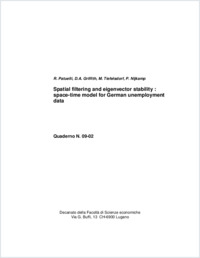Spatial filtering and eigenvector stability : space-time model for German unemployment data
- Patuelli, Roberto Istituto di ricerche economiche (IRE), Facoltà di scienze economiche, Università della Svizzera italiana, Svizzera
- Griffith, Daniel A. University of Texas at Dallas, USA
- Tiefelsdorf, Michael University of Texas at Dallas, USA
- Nijkamp, Peter VU University Amsterdam, The Netherlands
-
2009
22 p
English
Regions, independent of their geographic level of aggregation, are known to be interrelated partly due to their relative locations. Similar economic performance among regions can be attributed to proximity. Consequently, a proper understanding, and accounting, of spatial liaisons is needed in order to effectively forecast regional economic variables. Several spatial econometric techniques are available in the literature, which deal with the spatial autocorrelation in geographically-referenced data. The experiments carried out in this paper are concerned with the analysis of the spatial autocorrelation observed for unemployment rates in 439 NUTS-3 German districts. We employ a semi-parametric approach – spatial filtering – in order to uncover spatial patterns that are consistently significant over time. We first provide a brief overview of the spatial filtering method and illustrate the data set. Subsequently, we describe the empirical application carried out: that is, the spatial filtering analysis of regional unemployment rates in Germany. Furthermore, we exploit the resulting spatial filter as an explanatory variable in a panel modelling framework. Additional explanatory variables, such as average daily wages, are used in concurrence with the spatial filter. Our experiments show that the computed spatial filters account for most of the residual spatial autocorrelation in the data.
- Language
-
- English
- Classification
- Economics
- License
-
License undefined
- Open access status
- green
- Identifiers
-
- RERO DOC 11365
- ARK ark:/12658/srd1317962
- Persistent URL
- https://n2t.net/ark:/12658/srd1317962
Statistics
Document views: 166
File downloads:
- Texte intégral: 309
